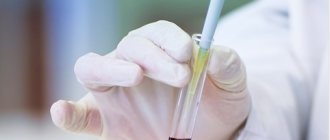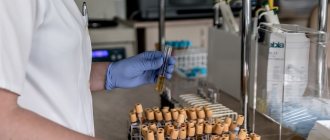Normal blood glucose levels range from 2.3 to 6.0 mmol/l on an empty stomach. After a meal, the value should not exceed 7.8 mmol/l. If the norm is violated, this indicates the development of diabetes. Moreover, even with a confirmed diagnosis, it is quite possible to stabilize the indicator. To do this, you need to adjust your diet, engage in regular physical activity and give up bad habits.
About glucose
Glucose nourishes the cells of the brain, nerve fibers, muscles, epidermis (skin), etc., and is the main energy resource for maintaining the vital functions of the human body. It is a monosaccharide that is formed from carbohydrates and amino acids during the breakdown of food into its constituent nutrients and other substances and fermentation (processing under the action of enzymes).
After glucose is released, most of it is absorbed into the blood and, with the help of insulin (an intrasecretory hormone of the pancreas), is delivered to the cells of the body. The liver transforms the remaining part of the monosaccharide into high molecular weight glycagon - a carbohydrate reserve. With the full production of insulin by the pancreas and the rational use of the hormone by the body's cells, a normal level of glucose is maintained in the blood, stable in relation to homeostasis (constancy of the internal environment of the body).
In the absence of disturbances, the amount of glucose formed is completely compensated by energy costs. A deviation of sugar levels from the norm in the direction of increase is called hyperglycemia, and in the direction of decrease - hypoglycemia. Glucose levels are directly affected by:
- Age.
- Nutrition.
- Neuropsychological state.
- Body mass.
- Physical activity.
- Work and rest schedule.
- Having bad habits.
- Chronic diseases.
- Pregnancy and menopause in women.
- Medicines used.
- Temporary disorders of psychosomatic health.
Abnormal blood sugar indicates a disruption in the body's metabolic processes and hormonal synthesis.
The principle of choosing a portable device
Pharmacies offer a wide range of modern glucometers. To ensure that your purchase does not disappoint, before purchasing, it is recommended to monitor online reviews of various models, sites comparing the cost of devices, and manufacturers’ sites with detailed descriptions of the devices.
It would be useful to compare prices in online pharmacies with the cost of glucometers in regular city pharmacies. If in doubt, you can consult your treating endocrinologist. When choosing a device, you should focus on the following parameters:
- the highest possible accuracy of the result;
- availability of consumable strips for constant sale;
- additional functions that will be useful for a particular patient (large font or sound signal for the visually impaired, cholesterol measurement, data transfer to a PC, etc.);
- ease of everyday use;
- price of glucometer and test strips;
- presence of auto-tuning function;
- Possibility of use in hiking conditions, ease of transportation;
- special storage case;
- speed of obtaining results;
- device warranty.
Thanks to the efforts of manufacturers, you can choose the design of the device to your liking.
How and when to check the indicator
Routine blood microscopy for glycemic levels in adults is performed as part of a medical examination (every three years). When diagnosed with diabetes, patients regularly donate blood for laboratory testing in a medical institution, and at the same time monitor their sugar levels independently using a portable glucometer.
In women, fluctuations in glucose may be associated with changes in hormonal status. During the perinatal period, sugar is determined at each screening (once every trimester) to prevent the possible development of GDM (gestational diabetes mellitus). During menopause, you need to monitor your blood glucose annually or as you feel. Children with a hereditary predisposition to diabetes are recommended to be tested at least once a year.
Other indications for research:
- Excess body weight.
- Decreased performance, drowsiness.
- Permanent thirst.
- Deterioration in health when changing your diet (diet).
One of the symptoms of hyperglycemia and hypoglycemia is polygaffia (increased appetite). If you are constantly hungry, you need to check your blood sugar
Methods and rules for collecting blood
A basic blood sugar test in a laboratory is taken from a finger or a vein. In newborn children, biological fluid (blood) can be collected from the heel. Venous blood values may differ slightly (increased by 12%). This does not apply to pathological manifestations and is taken into account when comparing with reference values.
Important! Blood microscopy for glucose levels is performed only on an empty stomach!
Regardless of its composition, any food that enters the body gives an impetus to the release of glucose into the blood. Therefore, objective sugar levels are recorded only on an empty stomach. In addition, on the eve of the study, it is recommended to follow the doctor’s instructions:
- Do not eat fast carbohydrates (confectionery and other sweets) for dinner.
- Refuse to take medications (except vital ones).
- Reduce physical activity and give up sports training.
Three days before the analysis, there should be no alcoholic beverages in the diet. In the morning, you should not have breakfast, perform oral hygiene (toothpaste is often supplemented with a sugar component), or chew gum.
Procedure at home
To check blood sugar at home, in addition to the device itself, you need to have a lancet (for puncture), strips, and an alcohol wipe. Mandatory conditions are: test strips match the glucometer model, use of test strips within the expiration date.
Working with a portable device begins with checking the settings. The code number on the display must match the set of numbers on the plate included in the test strip kit. Further actions are performed in the following order:
- remove the strip from the tube and seal the package tightly;
- insert the strip into the device, wait for the image on the display (a drop should appear);
- pierce the skin on the fingertip with a lancet (it is better to choose the side zone);
- remove the released blood with a cotton pad;
- place your finger on the strip when the next drop of blood is released and wait for the result (specific numbers on the display);
- treat the fingertip with an alcohol wipe.
After the procedure, the results and time of measurement must be recorded in the “Diabetes Diary”. Not allowed:
- carry out the procedure with wet hands;
- reuse consumables;
- store strips in an open tube;
- store the device without a trunk (case);
- use strips that do not match the glucometer model.
Failure to follow the rules may lead to distorted results. Detailed instructions for using a glucometer can be obtained during classes at the Diabetes School.
Normal fasting blood glucose levels
Laboratory measurements of sugar are in millimoles per liter (mmol/L). In some countries, the value is milligrams per deciliter. In terms of conversion, 1 mmol/l is equal to 18 mg/dl. By gender, glucose values for men and women are the same (with the exception of menopause and pregnancy).
Indicators increase after 60 years. This is due to an age-related decrease in the sensitivity (sensitivity) of body tissues to the endogenous hormone insulin. In healthy adults, the upper normative limit is represented by the number 5.5 mmol/l, the lower – 3.3 mmol/l. The ideal option is considered to be indicators that fall within the range of 4.2 to 4.6.
Reference values for fasting blood glucose according to age category
In an adult, with fasting sugar values from 5.7 to 6.7 mmol/l, prediabetes is diagnosed. This condition is characterized by a high risk of developing diabetes mellitus, but with timely diagnosis and adequate treatment it is reversible. People with diabetes are characterized by stable hyperglycemia. In this case, sugar values are criteria that determine the stage of the disease:
- Compensated (light or original).
- Subcompensated (moderate).
- Decompensated (severe or terminal).
Important! A single deviation of blood counts from the norm is not evidence of diabetes. The results can be distorted by improper preparation for the procedure, nervous excitement, or a sleepless night.
Regardless of how many units the results of the initial analysis exceed the norm, repeat microscopy should be prescribed. In case of constant excess of glucose values, the patient undergoes a number of additional tests.
Blood test after meals and normal indicators
Throughout the day, the blood composition is transformed several times depending on physical activity, the quantity and quality of foods eaten, emotional stress, etc. A blood sugar test after eating allows you to assess the stability of carbohydrate metabolism in the body. To obtain unbiased data, biofluid (blood) is collected four times: once on an empty stomach and three times after meals (with an hour interval between procedures). The maximum glucose level is observed after 60 minutes. after eating.
The normal value (in adults) is 8.9 mmol/l (for children - about 8.0 mmol/l). Optimal results for assessing metabolic processes are recorded during repeated assessment (with a two-hour interval). Reference glycemic values are 7.7 – 7.8 mmol/l. After 3 hours, sugar should return to its original levels (fasting norm).
Comparative table of sugar indicators in mmol/l for healthy people with diabetes (diabetes mellitus)
| Time patient | Before meals | In one hour | 2 hours | After 3 hours |
| Healthy body | 3,3–5,5 | up to 8.9 | 7,7–7,8 | Up to 5.7 |
| Type 1 diabetes | 7,8–9 | up to 11.0 | up to 10.0 | No more than 9.0 |
| Type 2 disease | 7,8–9 | up to 9.0 | 8,5–8,9 | Not higher than 7.5 |
For reference: In the female body, the processes of formation, absorption and consumption of glucose are more rapid than in men. Therefore, a taste for sweets is more common among women.
What is total sugar control?
To know how the body reacts to the prescribed diet and medications, you need to conduct careful self-monitoring of sugar concentration. Therefore, the device often takes measurements, namely:
- immediately after sleep;
- before breakfast;
- 5 hours after insulin injection;
- always before meals;
- after any meal after 2 hours;
- before sleep;
- before and after physical labor;
- after stress;
- if you suspect that your sugar has changed;
- in the middle of the night.
All numbers are entered into a notebook. This helps figure out what is causing the sugar spikes.
Clear interface
Norms and deviations
In case of persistent hyperglycemia, it is necessary to find out the reason for the deviation of the results. The most common is diabetes mellitus (prediabetes). Sometimes, there are other reasons for unstable sugar levels. To carry out advanced diagnostics, the patient is prescribed additional laboratory tests: GTT (glucose tolerance test), HbA1C analysis (quantitative assessment of glycosylated hemoglobin).
Important! Official diabetes is diagnosed only on the basis of a complete inpatient or outpatient examination of the patient.
Glucose tolerance test
Testing is a two-step blood test. Initially, biofluid is collected on an empty stomach. Blood is taken again 2 hours after the “glucose load”. The loading component is glucose (75 g) dissolved in water (200 ml). The patient drinks the liquid after the first test.
The glucose tolerance test determines the ability of body cells to metabolize glucose. Testing is mandatory for women during the perinatal period and patients aged 30+ who are suspected of having non-insulin-dependent diabetes. Impaired glucose tolerance is a condition of prediabetes.
Interpretation of GTT results (sugar in capillary blood in mmol/l)
| Diagnostic data | Fine | Prediabetes | SD |
| Before meals | < 5,5 | < 6,1 | > 6,2 |
| After load | < 7,8 | > 7,8–11,0 | > 11,1 |
In difficult cases, blood is drawn every 30 minutes. Based on the data obtained, a sugar curve is compiled and analyzed.
The amount of glycosylated hemoglobin (HbA1C) in the blood
Glycosylated (glycated) hemoglobin is a permanent combination of glucose and hemoglobin (the protein component of red blood cells). It is formed in the blood during the addition of a monosaccharide to a protein, and occurs without the participation of enzymes (non-enzymatic glycosylation). Hemoglobin does not change its structure inside red blood cells for 4 months. HbA1C analysis determines the retrospective glucose content, that is, the quality of carbohydrate metabolism is analyzed over the past 120 days.
Blood sugar levels in children
Glycated hemoglobin is measured as a percentage. In healthy children under 14 years of age, the HbA1C norm does not exceed 6%. A deviation of more than one (7%) means a high probability of developing diabetes. Age norm for adults:
- Up to 40 years – less than 6.5%, permissible deviations 6.5-7.0, with values >7.0% diabetes is defined.
- Over 40 – less than 7.0%, borderline values are 7.0-7.5, unacceptable excess of the norm – 7.5%.
- Age category 65+ – less than 7.5%, limit values 7.5-8.0, diabetes is diagnosed with results >8.0%.
For diabetics, HbA1C analysis is a means of monitoring the disease, assessing the risk of complications, and checking the effectiveness of therapy. Normal and abnormal values for diabetic patients are presented in the table.
Differentiating the type of diabetes
Consistently elevated results of all studies are an indication for testing the blood for the amount of antibodies to glutamate decarboxylase (GAD antibodies). The analysis is carried out to differentiate the type of diabetes. A healthy person maintains a certain level of GAD antibodies. Their permissible rate is 1.0 units/ml. When the content is exceeded, the test is considered positive, that is, type 1 diabetes is determined.
Important! Blood sugar can be either high or low. Both conditions indicate disturbances in the functioning of the body. To effectively eliminate them, it is necessary to identify the cause of unstable glycemia.
Diabetes mellitus in children
Diabetes mellitus in children is a chronic disorder of carbohydrate metabolism, in which insulin production is disrupted and hyperglycemia develops. When the disease occurs, the child loses weight sharply, despite a good appetite, he is constantly tormented by thirst, and urination becomes more frequent. Typically, children are diagnosed with type 1 diabetes, also called insulin-dependent.
Factors provoking the disease may be the following:
- genetic predisposition;
- viral infections, including measles, rubella, herpes;
- stress;
- artificial or mixed feeding, early introduction of cow's milk and grain crops, monotonous carbohydrate foods;
- surgical intervention;
- baby's weight at birth is 4.5 kg;
- excess weight, physical inactivity;
- diathesis;
- endocrine disorders, including Itsenko-Cushing syndrome, acromegaly, pheochromocytoma;
- pathologies of the digestive tract;
- autoimmune diseases such as rheumatoid arthritis, scleroderma, Libman-Sachs disease, periarteritis nodosa.
Recently, more and more often children are diagnosed with type 2 pathology, the main reasons being excess weight and obesity.
The main causes of unstable glycemia
When test results do not meet the standards, the following is diagnosed:
- Hyperglycemia (more than 5.5 mmol/l on an empty stomach).
- Hypoglycemia (less than 3.3 mmol/l before meals).
The main reason why glucose concentration increases is diabetes. A decrease in sugar levels below the established level in diabetics occurs due to a violation of the treatment regimen or exceeding the prescribed dosage of insulin (glucose-lowering drugs). The following factors influence changes in glucose levels:
| Hyperglycemia | Hypoglycemia |
| Chronic pancreatic diseases, latent cancer, hyperthyroidism (increased production of thyroid hormones), incorrect treatment with hormone-containing medications, vascular atherosclerosis, stage 2 and 3 hypertension, chronic alcoholism, regular physical overload, an abundance of sweets in the diet, lack of vitamins and minerals substances, distress (constant psycho-emotional discomfort), obesity. | Prolonged fasting, sudden nervous shock, latent or diagnosed insulinoma (a hormonally active tumor of the pancreas that produces excessive amounts of insulin), physical activity exceeding capabilities, renal decompensation, liver pathologies in the decompensated stage, severe alcohol or drug intoxication, mental overstrain. |
To determine what reason influenced the change in blood composition, it is necessary to undergo a full medical examination.
Preparing for analysis
It is necessary to donate blood for glucose on an empty stomach. It is recommended to maintain an interval of at least 12 hours after the last meal. At this time, you should also avoid chewing gum and drinks. You can drink water without additives. You should also avoid emotional and physical overload.
For a more accurate test result, 2 days before donating blood, it is recommended to exclude liver and kidneys from the diet, limit the consumption of meat, fish, tea and coffee, and also refuse to do physical exercise.
Figure 2. Glycemic index of foods. Image: IrinaPotter/Depositphotos
Results
A blood sugar test is an indicator of metabolism and the endogenous work of the pancreas to produce insulin. When carbohydrate balance and hormone synthesis are disturbed, hypoglycemia (low blood sugar levels) or hyperglycemia (high blood sugar) develops. Basic and advanced diagnostics are performed to determine glucose levels.
The second option includes: glucose tolerance test and analysis of glycated hemoglobin levels. For the study, venous or capillary blood is taken. The main condition for obtaining objective results is to take the test on an empty stomach. The normal level of glucose in the blood is 3.3–5.5 millimoles per liter. In older people, the control indicators are not significantly higher.
A slight but stable excess of glucose levels is defined as prediabetes - a reversible change in biological processes in the body. For diabetic patients, there are separate reference sugar values that determine the stage of the disease. Unstable glucose levels are an indicator of a failure of metabolic and hormonal processes. To diagnose the exact cause of unstable glycemia, additional laboratory and hardware examination is necessary.








